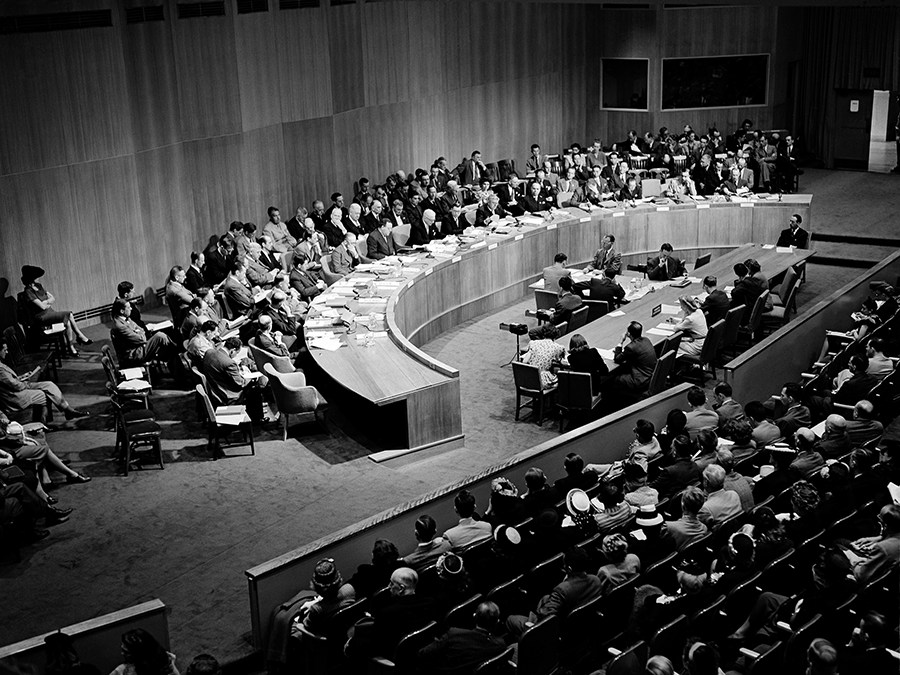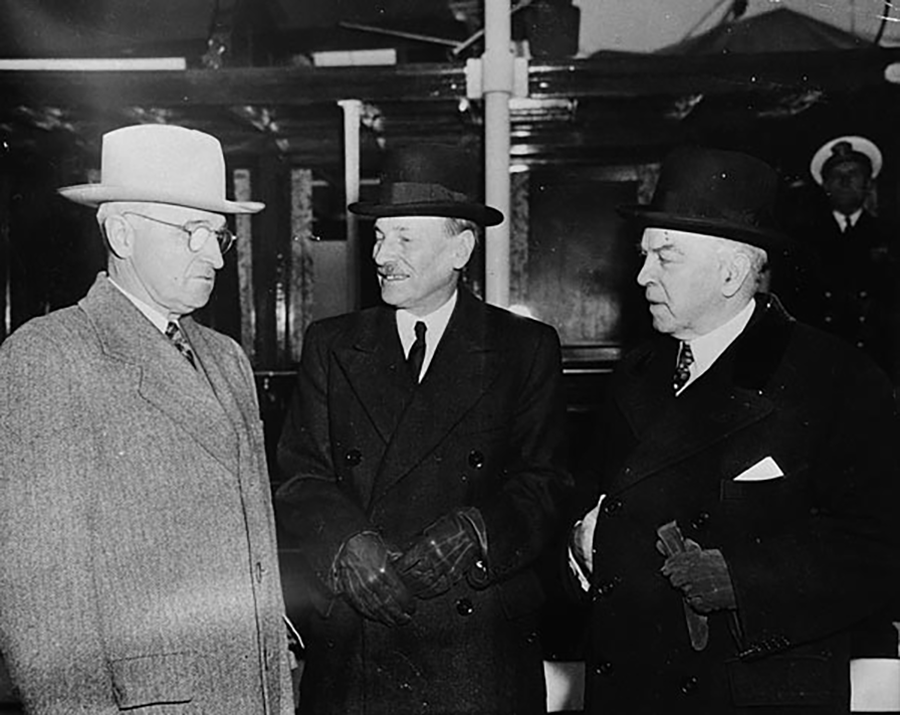First UN Resolution Holds Lessons for Latest Nuclear Treaty
January/February 2021
By Ryan A. Musto
The UN General Assembly’s first resolution, passed 75 years ago on January 24, 1946, looked to “deal with the problems raised by the discovery of atomic energy.” Specifically, Resolution 1(I) created the UN Atomic Energy Commission (UNAEC) and charged it with making proposals for “the elimination from national armaments of atomic weapons” and the use of atomic energy “only for peaceful purposes.”1
 Scholars, activists, jurists, and policymakers celebrate the resolution as a foundational moment in a collective push for nuclear disarmament, an effort that has seen its latest achievement with the 2017 Treaty on the Prohibition of Nuclear Weapons (TPNW). Set to enter into force on January 22, the TPNW seeks to outlaw nuclear weapons worldwide. In its preamble, the TPNW recalls the resolution as a source of inspiration, and the two initiatives are widely regarded as bookends of a lifetime commitment by the United Nations to ban the bomb.
Scholars, activists, jurists, and policymakers celebrate the resolution as a foundational moment in a collective push for nuclear disarmament, an effort that has seen its latest achievement with the 2017 Treaty on the Prohibition of Nuclear Weapons (TPNW). Set to enter into force on January 22, the TPNW seeks to outlaw nuclear weapons worldwide. In its preamble, the TPNW recalls the resolution as a source of inspiration, and the two initiatives are widely regarded as bookends of a lifetime commitment by the United Nations to ban the bomb.
The resolution, however, was not the lodestar many in the nuclear policy community imagine. The United States crafted its language to avoid a nuclear ban. Moreover, by placing the UNAEC under the direction of the UN Security Council, the resolution helped to consolidate an unequal global nuclear order. Less a model to achieve, the resolution is a reminder of challenges the TPNW must overcome on the path to global zero.
Bucking a Ban
In November 1945, three months removed from the U.S. atomic bombings in Japan, U.S. President Harry Truman hosted the prime ministers of Canada and the United Kingdom in Washington to chart a position on the international control of atomic energy. Vannevar Bush, the director of the Office of Scientific Research and Development, took charge of the U.S. position.
 Bush outlined a three-staged proposal he hoped the Soviet Union, the estranged wartime ally, would support. The first two stages would use the UN to facilitate the sharing of atomic information and establish inspections for materials used in making nuclear weapons. The third stage would dismantle atomic bombs, transfer their fissile material to peaceful nuclear power plants, and help ensure that the future production of fissile material be used solely for peaceful purposes.2
Bush outlined a three-staged proposal he hoped the Soviet Union, the estranged wartime ally, would support. The first two stages would use the UN to facilitate the sharing of atomic information and establish inspections for materials used in making nuclear weapons. The third stage would dismantle atomic bombs, transfer their fissile material to peaceful nuclear power plants, and help ensure that the future production of fissile material be used solely for peaceful purposes.2
Bush’s goals, however, did not include a ban on the bomb. “We also want to have atomic bombs and to be in a clear position to use them promptly, if there is any chance that our enemy has them,” Bush wrote to Secretary of States James Byrnes. “Hence our program toward international understanding should involve no premature ‘outlawing of the bomb,’ which is a dangerous phrase.” Bush believed that a determined state would be able to make an atomic bomb and thus found any nuclear prohibition futile. What needed to be outlawed in the atomic age, he argued, was not the weapons that waged war, but war itself.3
With all fissile material stored in “bar form” for use in nuclear power plants, Bush looked to prevent any surprise nuclear attack. The time it would take to divert fissile material from nuclear power plants into weaponized form, he reasoned, would provide ample warning. Yet, Bush was not prepared to forgo the ability to make that transfer. “The cost of this step to us is merely that it would make the material unavailable for atomic bombs without a period of preparation,” Bush assured Byrnes.4 It meant the United States would maintain a latent nuclear weapons capability and be able to reconstitute an atomic arsenal in a time of need.
Bush led the creation of the joint statement the three leaders issued at the conclusion of the summit. The so-called Washington Declaration dealt a blow to a ban on the bomb in varied ways. It claimed that no nation should possess an atomic monopoly, a means of assurance to the UK of an Anglo-American atomic partnership. It also held that “no system of safeguards that can be devised will of itself provide an effective guarantee against production of atomic weapons by a nation bent on aggression.” In other words, any nuclear ban seemed unenforceable. Finally, the declaration called for the creation of the UNAEC, which would make proposals for the elimination of atomic bombs, not as a category of weapon but from national armaments. Some thought this stipulation meant that an international authority, perhaps the UN, might wield a nuclear arsenal. Overall, one informed source claimed the Washington Declaration looked to avoid the “spurious security” of the 1928 Kellogg-Briand Pact that failed to outlaw war.5
Serving the Security Council
To make the Washington Declaration’s call for the UNAEC a reality, the United States required Soviet support. In December 1945, the Soviet Union agreed on the condition that the UNAEC serve under the UN Security Council. This arrangement would give the permanent members of the Security Council and Canada veto power over any action by the UNAEC.6
With language taken directly from the Washington Declaration, Resolution 1(I) passed unanimously on January 24, 1946, but it hardly constituted a “collective delegitimization” of nuclear weapons.7 The New York Times noted that the General Assembly adopted the resolution “without even a serious attempt to analyze what it meant. The general attitude was that members could not change it without antagonizing the powers that controlled the atomic secrets, so they did not try.”8 Feeble protests, though, had emerged. Mexico called to adjourn the General Assembly to seek further clarification. The Philippines argued that the question of atomic energy was “so transcendental that there should be full discussion” and reprimanded the great powers for their attempt to “railroad the matter through.”9 Nevertheless, the great powers ensured that the resolution passed in a “swift, businesslike manner.”10
By placing the UNAEC under the UN Security Council, the resolution stripped the General Assembly’s small and medium-sized members of power to steer the world’s nuclear fate. The injustice was not lost on Philippine delegate Pedro Lopez, who declared that the resolution “would result in embarrassing, instead of glorifying, this Assembly.” As Lopez asked his counterparts in vivid terms, “If this text is adopted, should we not find ourselves in the same awkward predicament as a woman who gave life to a child and yet was not permitted to fondle it, nor to direct the course of its upbringing in accordance with the image of her ideal, or even to see the child? Would you conceive of a God who was impotent to give our fates and destinies any guiding direction after having created us?”11
Within months, the United States and Soviet Union doomed the UNAEC with dueling plans for nuclear disarmament. Faced with perpetual deadlock, the UNAEC became inactive by the end of the decade and dissolved shortly thereafter.
Trouble for the TPNW?
The loopholes and inequities Resolution 1(I) looked to exploit are obstacles the TPNW must overcome. The TPNW calls for the “irreversible elimination of nuclear weapons,” but the threat of nuclear latency, which Bush guarded against and relied on, remains. A 1997 report by the National Academy of Sciences predicted that even after all nuclear weapons had been eliminated, a score of states “could in a national emergency produce a dozen simple fission weapons in as little as a few months, even if no effort had been made to maintain this capability.”12 A more recent study published by the Wilson Center concurs. “In a world of greatly reduced or zero nuclear weapons, latency would create high levels of crisis and arms race instability. Latency might enable states to rapidly reverse their disarmament activity.”13 The TPNW offers no solution to this vexing problem, and some argue that it must prohibit “nuclear-weapons usable materials for any purpose” to meet the danger.14
The TPNW also calls on a “competent international authority” to enforce its mission, but it must avoid the power imbalance found with the subjugation of the UNAEC to the Security Council. The International Atomic Energy Agency is set to play a major role in TPNW verification, but the great powers designed and dominate its operation. Perhaps the creation of a parallel body under the TPNW composed of UN employees and a diverse cadre of independent experts would offer a solution.15
Proponents of the TPNW find one of its greatest contributions to be normative. They believe the TPNW, negotiated by more than 120 non-nuclear-weapon states of the General Assembly and civil society groups, will stigmatize and delegitimize nuclear weapons enough to change the behavior of nuclear-armed states and their allies. Its bottom-up push for a global ban on the bomb exceeds the intent behind Resolution 1(I), but supporters must beware the pitfalls of Resolution 1(I) that remain.
ENDNOTES
1. UN General Assembly, “Establishment of a Commission to Deal With the Problems Raised by the Discovery of Atomic Energy,” A/RES/1(I), January 24, 1946.
2. Vannevar Bush to James Byrnes, memorandum, November 5, 1945, in Foreign Relations of the United States: Diplomatic Papers, 1945, General: Political and Economic Matters, Volume II, doc. 26, pp. 69–73, https://history.state.gov/historicaldocuments/frus1945v02/d26.
4. Vannevar Bush and L.R. Groves to James Byrnes, memorandum, November 9, 1945, in Foreign Relations of the United States: Diplomatic Papers, 1945, General: Political and Economic Matters, Volume II, doc. 27, p. 74, https://history.state.gov/historicaldocuments/frus1945v02/d27.
5. Paul W. Ward, “U.S., Britain and Canada Propose UNO Establish Group to Design Guards,” The Baltimore Sun, November 16, 1945, p. 1.
6. Campbell Craig and Sergey Radchenko, The Atomic Bomb and the Origins of the Cold War (New Haven, CT: Yale University Press, 2008), p. 105.
7. Nina Tannenwald, Nuclear Taboo: The United States and the Non-Use of Nuclear Weapons Since 1945 (Cambridge, UK: Cambridge University Press, 2007), p. 101.
8. James Reston, “UNO Adopts Plan for Atom Control by Unanimous Vote,” The New York Times, January 25, 1946, pp. 1, 3.
9. Sydney Gruson, “UNO Unit Adopts Bomb Resolution,” The New York Times, January 22, 1946, p. 4.
10. Sydney Gruson, “Atom Commission Has a Hard Task,” The New York Times, January 27, 1946, p. E5.
11. Record of the seventeenth UN General Assembly plenary meeting, January 24, 1946, https://digitallibrary.un.org/record/482340/files/A_PV-17-EN.pdf.
12. Committee on International Security and Arms Control, National Academy of Sciences, The Future of U.S. Nuclear Weapons Policy (Washington, DC: National Academy Press, 1997), p. 97.
13. Joseph F. Pilat, ed., “Nuclear Latency and Hedging: Concepts, History, and Issues,” Wilson Center, September 2019, p. 7, https://www.wilsoncenter.org/sites/default/files/media/documents/book/nuclear_latency_and_hedging_-_concepts_history_and_issues.pdf.
14. Zia Mian, Tamara Patton, and Alexander Glaser, “Addressing Verification in the Nuclear Ban Treaty,” Arms Control Today, June 2017, pp. 14–22.
15. Tamara Patton, Sébastien Philippe, and Zia Mian, “Fit for Purpose: An Evolutionary Strategy for the Implementation and Verification of the Treaty on the Prohibition of Nuclear Weapons,” Journal for Peace and Nuclear Disarmament, Vol. 2, No. 2, 2019, pp. 397–404.
Ryan A. Musto is a MacArthur Nuclear Security Fellow at the Center for International Security and Cooperation at Stanford University.
